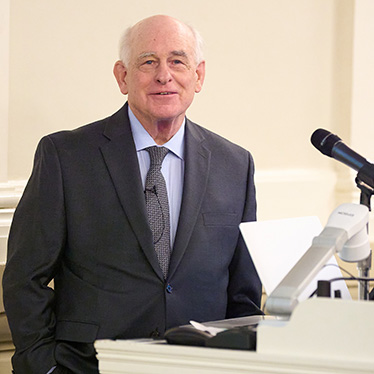Egyptologist Shares Findings of Everyday Life of the Pyramid Builders During Phanstiel Lecture
November 29, 2024
SU News
The grandeur of the pyramids of Giza has drawn archeologists to study their ancient mysteries and fascinated peoples for centuries. The elaborate engineering and architecture of these structures are marvels for the ages, leading most people to ask how they were built.
For Egyptologist Mark Lehner, who has researched the monuments and environs of the Giza Plateau for decades, his question for most of his career has not been about how they were built but rather who crafted these enduring wonders.
“I was simply asking where are all the people? Where’s the settlement? What would it tell us about their lives if we could dig into it with scientific archaeology?” said Lehner, who presented the Phanstiel Lecture, “The People Who Built the Pyramids—How We Know,” earlier this month in Maxwell Auditorium.

To get to those answers, “I realized that I had to turn my back to the pyramids and look beyond them, around them, to understand the pyramids themselves,” Lehner said. “Because if you don’t understand the elementary structures of everyday life of a people, of a culture, you don’t understand their monuments.”
A distinguished archeologist and founder and president of Ancient Egypt Research Associates (AERA), Lehner has over 40 years of experience studying Egypt’s ancient history. Founded in 1985, the AERA team expanded research on the infrastructure of the pyramid builders, revealing insights into the lives of the ancient workers.
Lehner’s work includes such groundbreaking projects as mapping the Great Sphinx and leading the Giza Plateau Mapping Project, an initiative that unearths and studies Old Kingdom settlements.
Sponsored by the Howard G. and S. Louise Phanstiel Chair in Leadership, Lehner’s visit was one of the Maxwell School of Citizenship and Public Affairs’ centennial events.
“It’s a particular honor to be here celebrating 100 years of the Maxwell School, and I realize that we’re way deep into time here compared to a lot of studies here at the Maxwell School, and I’m just wondering if this deep dive into early civilization history might serve as some kind of notice about what is citizenship, what is public affairs, what was it 4,500 years ago?” Lehner said. “What does citizenship mean in these very early periods? And for that matter, was there even such a thing as public versus private?”
Lost City of the Pyramids
Presenting photos and diagrams of the Giza Plateau and its famous sites, Lehner spoke about his discoveries in the Lost City of the Pyramids, a site south of the Sphinx where the AERA team began excavating in 1988. The site stretches south from a colossal ancient stone wall known as Heit el-Ghurab (or “Wall of the Crow”). Here, AERA excavations are revealing an urban settlement that served those building the great pyramids 4,500 years ago.
Below the sands, AERA archeologists exposed the architectural footprint of their labor organization, Lehner said. They found small houses, streets, bakeries, a royal administrative building and a complex of galleries that would have housed the workers.
Animal bones, ancient plants and chips of stone tools—these tiny fragments, which they found through a meticulous sieving process—revealed everyday life.
“We had evidence from the ancient bone that up to several thousand people were eating meat every day, prime beef,” said Lehner, who also noted they found dozens of bakeries. “So we came up with the barracks hypothesis. The idea that people in the provinces were pulsed through the gallery complex during periods of obligatory labor.”
They also discovered wares and remnants of materials that would have been brought in from other parts of Africa and the Middle East.
Their findings and hypotheses have been substantiated by an important discovery in the desert caves at Wadi al-Jarf near the Red Sea. Fellow archeologist Pierre Tallet and his colleagues found the world’s oldest inscribed papyri, written accounts by the people who built the pyramids.
Lehner and Tallet collaborated to connect the writings with the physical remnants. “This is just one example of the evidence we used to reconstruct the pyramid builders’ floodplain and waterways,” Lehner said. “We think they actually dredged these harbors and waterways to the depths of the main trunk channel of the Nile, to a Western Nile branch, to bring water as close as possible to the foot of the Giza Plateau.”
Training the Next Generation of Archeologists
Lehner discussed another important aspect of AERA: training Egyptian archeologists to continue this important work. With funding from private sources and the U.S. Agency for International Development, AERA has trained 350 scholars over 19 years.
“We became one of the largest deployments in Egyptian archeology, and these students have gone on to become major officials and directors within the Ministry Tourism and of Antiquities,” Lehner said.
Following Lehner’s lecture, Maxwell School Dean David M. Van Slyke recognized the archeologist’s work and how his research “shines a light” on those who contributed to these monumental achievements but are often overlooked.
“Dr. Lehner uncovers not only the physical infrastructure that sustained these great undertakings but also the values, daily lives and ingenuity of the ancient workforce that powered them,” Van Slyke said. “The builder city stands as a tribute to these individuals and reminds us that behind every monumental structure are stories of human resilience and creativity.”
By Kathleen Haley
Related News
Commentary

Apr 24, 2025
Commentary

Jan 21, 2025
Commentary

Dec 30, 2024
School News

Dec 20, 2024